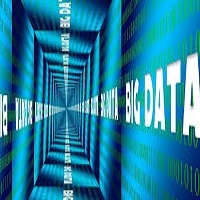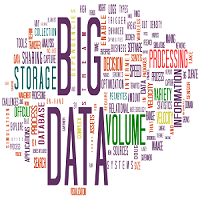
 Data Structure
Data Structure Networking
Networking RDBMS
RDBMS Operating System
Operating System Java
Java MS Excel
MS Excel iOS
iOS HTML
HTML CSS
CSS Android
Android Python
Python C Programming
C Programming C++
C++ C#
C# MongoDB
MongoDB MySQL
MySQL Javascript
Javascript PHP
PHPPhysics
Chemistry
Biology
Mathematics
English
Economics
Psychology
Social Studies
Fashion Studies
Legal Studies
- Selected Reading
- UPSC IAS Exams Notes
- Developer's Best Practices
- Questions and Answers
- Effective Resume Writing
- HR Interview Questions
- Computer Glossary
- Who is Who
The magnitude of big data
Large volumes of structured and unstructured data are essentially referred to as ‘Big Data;’ and is produced by almost all sources around us such as social media exchange, digital processes, mobile devices, sensors etc. Big Data provides insights into patterns, trends, and correlations with other entities in the business world. Big Data swamps businesses on a regular daily basis, and due to the speed and accuracy with which it is analyzed, it leads to enhanced and accurate decisions via tactical business steps. As it is variable and complex and comes from various sources, it is imperative to connect it and associate it with other systems.
- Big Data answers questions related to cost and time reduction, new product development, and intelligent decision making.
- Big Data also aids in establishing origins of failures and defects, calculating risk portfolios and detecting frauds.
“Without big data analytics, companies are blind and deaf, wandering out onto the web like deer on a freeway.” – Geoffrey Moore
Types and Sources
The global analyst firm Gartner views Big data as three Vs: the amount of data (volumes); the pace at which information is generated and streams in the organization (velocity), could be via smart meters and sensors that aid in near real-time data; and the forms of data (variety).
Big Data leads to enhanced customer management, optimization of operations acts as a resource for competitive advantage, prevents threats/frauds, and provides insights and benefits for/from newer sources of revenue.
Structured data is one that is typically derived from man-machine interactions, for eg. web applications, business transactions, sensors; whereas unstructured data is derived from traditional databases, for eg. metadata, twitter, video, audio etc. Apart from the volume, it is imperative for an organization to understand as to what they do with it and that it must hold some meaning, essentially leading to analysis for insights which leads to better and informed decisions and calculated business moves.
Rising Importance
While huge amounts of data are harnessed, it allows organizations to discover new opportunities which result in higher profits, efficient and effective operations with higher productivity and

satisfied customers. Cost reduction occurs due to the usage of Big Data technologies such as Hadoop and cloud-based analytics as they deal with storing voluminous data along with finding efficient ways of carrying out the business. Again, along with Hadoop and in-memory analytics, information can be examined and taken action upon instantly. Due to this analysis, customer requirements are better expressed leading to better and newer products for customers.
Wider Acceptance in Diverse Industries
Big Data is being used in travel, hospitality, healthcare, retail, government, banking, education, manufacturing etc. Customer satisfaction is considered the highest in travel and hospitality industry. These businesses use Big Data to identify and resolve issues related to customers before they end up losing them. In healthcare, Big Data is all too required with for physicians to find out

life-saving treatments options without delay. Typically used by law enforcement agencies, Big Data aids in reorganizing operations and provides a holistic view of the criminal movements. With Big Data, retailers gain an insight into buying habits, trends and through customer loyalty programs, they go on to create better products for customers leading to larger profits. Banking uses Big Data to minimize fraud and enhance customer satisfaction. Educators use Big Data for implementing better school systems with improved support of teachers and principals with an advanced curriculum and enhanced evaluation systems. Manufacturing uses Big Data for enhancing the quality of products, minimizing waste in product development, and solving of challenges faster.
High-performance analytics lets you do things you never thought about before because the data volumes were just way too big. For instance, you can get timely insights to make decisions about fleeting opportunities, get precise answers for hard-to-solve problems and uncover new growth opportunities – all while using IT resources more effectively. (From the white paper Big Data Meets Big Data Analytics, ref: SAS)
Application and Analysis of Big Data
Big Data is analyzed through several technologies. Here are a few:

Data Management − For analysis, data must be made reliable and of high quality. Once this is done, a customized data management program can be established for everyone to behave and act on effectively.
Data Mining − This technology is applied to data which gives patterns and trends to enable answering complex issues. With the aid of data mining software, unwanted data is left aside and only the relevant data is used to take informed decisions.
In-memory Analytics − Instead of analyzing data from hard disk, the data is analyzed from the system memory. One can create models, test new scenarios, take informed business decisions, stay responsive, and run various interactions and scenarios.
Hadoop − This is a free open source software framework. Apart from storing large amounts of information, one can runs applications and store data on commodity hardware. This model processes data at a great speed.
Predictive Analytics − This technology uses machine learning methods, information and statistical algorithms to find future outcomes reaching the greatest evaluation possible for organizations with the help of historical data. Common predictive analytics are risk, fraud discovery, marketing, and operations.
Text Mining − With the help of this technology, companies can analyze text data from the internet, books, blogs, twitter, emails, surveys and other text-related material for details gone unnoticed before. This uses technologies such as machine learning or natural language processing for discovering new ideas.
It is imperative for organizations to find cheaper ways and means to store large amounts of data, with faster processors, free/cheap open source and big data platforms, comprise of high connectivity to the internet, analogous processing, grouping and visualization, large grid settings along with the capability to use cloud computing and other adaptable resource distribution assemblies.
Big Data is changing the way organizations use, handle and derive information and their answers to business related complex problems. Enhanced, new and innovative products and services emerge from processing and analysis of Big Data. And organizations must know how to use this data by converting it (raw into meaningful data) while further storing, managing, analyzing only the relevant data, to aid in recognizing approaches leading to better decisions.

